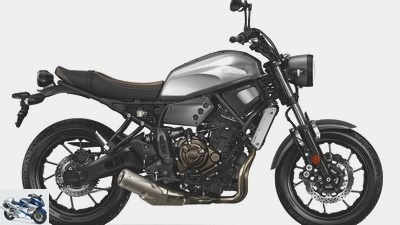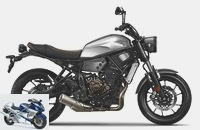Menus

Yamaha
Yamaha innovations for 2016
From MT-07 to Yamaha XSR 700
"Faster sons", faster sons – this is what Yamaha calls the philosophy behind the new XSR 700. It aims to harmonize the design of the fathers with the technology of the sons. In the case of the new XSR 700 this means that the modern MT-07 comes with the classic design of the XS 650. Difficult…
C.harmant, the idea is just charming. And so obvious. Ducati showed the way. A two-cylinder with a strong character, not too big and not too small, but really crisp, and all around a successful scrambler appearance between retro and modern. This is currently the case – and the Japanese have the right engine on their shelves. The MT-07-Twin with the V2 sound generating crank pin offset of 270 degrees is currently probably the best drive in its class, and is compact and inexpensive to manufacture. An ideal everyday motor – and therefore perfectly suited for such a real “Faster Sons bike”. So one “where the sons respectfully continue the work of their fathers and later simply move faster with their creations.” This is how Yamaha describes it.
Buy complete article

Yamaha innovations for 2016
From MT-07 to Yamaha XSR 700
XSR 700 is faster than its mother in spirit, the blessed XS 650, does not have to be clarified by a comparison test. That takes care of the paper form: 75 HP, 178 kilos with a full tank – the old lady can’t go with that. In 1976, in its second edition, it produced just 50 hp at a weight of 230 kilograms. That meant: At 180 km / h the end was lying flat, at that time MOTORRAD measured 167 km / h with the driver seated. And yet he was enthusiastic about the twin and its “calm, but robust way of pounding around”.
Of course, that’s all it takes today to put you in a good mood on a motorcycle like the new XSR 700. One thing is therefore clear beforehand: it will not be the engine. And probably not in the price either. This is not yet known, but if you take the almost 6000 euros of the organ donor MT-07 as a basis and a small surcharge due to the higher-quality materials (double-structured leather seat bench, aluminum tank, aluminum radiator panels and aluminum wheel cover), it is also calculated the XS successor will not ruin a buyer. For comparison: a Ducati Scrambler starts at 8390 euros.
Why is the attentive reader waiting for a “but”? Why does one or the other not rub their hands with enthusiasm in view of a bike in which “Shinja Kimura’s view of the Faster Sons philosophy has taken shape in a concept motorcycle”? Because – at least as the first photos of the XSR 700 suggest – even a famous customizer, whose creations are usually traded for around 100,000 euros, obviously cannot ignore the laws of the modular system. That means: The central assemblies such as the engine and frame remain unchanged, while the surrounding areas are constantly being replaced by new components, ideally always creating new motorcycle creations, ideally from athletes to enduro bikes. Or even to the modern classic, as the XSR 700 is now supposed to represent.
But this spark does not want to ignite immediately with the new Yamaha, because the classic lines of the XS 650 are not found in the supposed successor. The decisive reason for this can be found in the frame construction. The backbone frame made of tubular steel with its idiosyncratic, broad struts for the upper engine mounts does not allow a tank to be slipped over it. Since the MT-07-Twin sucks in its air in the classic way via the airbox under the seat, there is no space for a fuel barrel. The new 14-liter aluminum tank of the XSR 700 can only be placed on the frame – and is accordingly tall. Much higher than the steering head, which is surprisingly low for a vehicle in this category.
That doesn‘t look classic, but rather unusual on a motorcycle of this shape. The lines, cables and motor brackets visible on the XSR 700 also seem rather unclassical, which on the MT-07 are still partially hidden by plastic panels or are simply less annoying. The same applies to the banana swing arm, which has also been taken over unchanged, and the under-engine exhaust system with its short stub silencer.
The first visual impression takes getting used to. The first driving impression, however, should be convincing. Because so little has changed in relation to the MT-07. Pirelli Phantoms as the first tire instead of the Michelin Pilot Road 3, plus a different handlebar, slightly higher and more inclined towards the driver – that was due to the technical differences. And if you still want to work on the optics: The rear frame is screwed on, and Yamaha will offer a lot of accessories. For faster sons.
Technical specifications
Yamaha
The new Yamaha in a silver guise.
Related articles
-
Honda CB 1100 RS, Kawasaki Z 900 RS and Yamaha XSR 900 in the test
bilski-fotografie.de 31 photos bilski-fotografie.de 1/31 The Honda CB 1100 RS. bilski-fotografie.de 2/31 A feast for the eyes: Visually, the Honda is…
-
Photo: Yamaha 30 photos Yamaha 1/30 The new Yamaha YZF-R6 for the 2017 model year. Yamaha 2/30 The new Yamaha YZF-R6 for the 2017 model year. Yamaha …
-
Relatives Yamaha XS 650 and XSR 700
Gargolov Opinion: Yamaha XS 650 and Yamaha XSR 700 MT-07 as XS 650 heiress? Content of Uli Holzwarth on Yamaha’s desperate efforts to convert an MT-07…
-
Kawasaki, KTM, Triumph and Yamaha
Jahn 20th photos triumph 1/20 triumph 2/20 From the development phase: a model with a low-lying silencer. triumph 3/20 triumph 4/20 The touring…
-
Yamaha MT-09 – SP from 2016 – Technical data
Yamaha MT-09 / SP Specifications from 2016 Technical specifications engine Number of cylinders, type 3, in-line engine power 84.6 kW / 115.1 hp at 10,000…
-
Yamaha XSR 900 from 2016 – Technical data
Yamaha XSR 900 Specifications from 2016 Technical specifications engine Number of cylinders, type 3, in-line engine power 84.6 kW / 115.1 hp at 10,000…
-
Yamaha WR 450 F from 2016 – Technical data
Yamaha WR 450 F technical data from 2016 Technical specifications engine Number of cylinders, type 1, engine Displacement 449 cc Number of valves four…
-
Yamaha MT-07 from 2016 – Technical data
Yamaha MT-07 Specifications from 2016 Technical specifications engine Number of cylinders, type 2, in-line engine power 55.0 kW / 74.8 hp at 9,000 rpm…
-
Jahn Review Yamaha WR 250 X Single cylinder of the future With its sophisticated technology, the Yamaha WR 250 X shows the way into the future of sporty…
-
Comparison test: Aprilia, BMW, Husqvarna, KTM and Yamaha
fact Comparison test: Aprilia, BMW, Husqvarna, KTM and Yamaha Single cylinder fun bikes A big heart beats in them, a very big one in fact. The new…